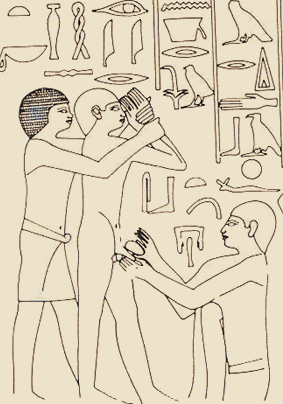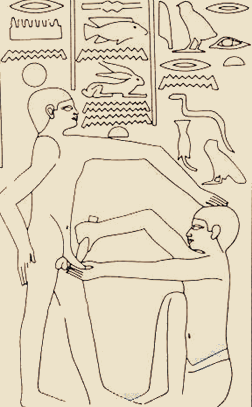Home Page
The latest articles, features and news.


Read About...


|
| | |
|
8 May 2006
Circumcision Through The Ages
by Paul A.
 Last week I speculated on the probable origins of the practice of circumcision. No one knows when or where people started slicing off their foreskins and what I provided was guesswork at best. But it�s time now for some hard history. The earliest reference to circumcision is provided in a bas relief found in the Egyptian necropolis of Saqqara and dated around 2400 BCE. Now it seems to me that this could just as easily be interpreted as a Nubian hand-job. What is purported to be a knife looks more like a jar of hand-lotion and everyone appears to be having a good time, but hey, who am I to argue with the experts. The point is moot anyway. Less than one hundred years later, an Egyptian scribe named Uha described a mass circumcision of 120 boys (the ancient Egyptians were nothing if not efficient) so we can be sure that even if the bas relief does depict a five-knuckle-shuffle, circumcision was indeed being practiced in Egypt around this time.
Last week I speculated on the probable origins of the practice of circumcision. No one knows when or where people started slicing off their foreskins and what I provided was guesswork at best. But it�s time now for some hard history. The earliest reference to circumcision is provided in a bas relief found in the Egyptian necropolis of Saqqara and dated around 2400 BCE. Now it seems to me that this could just as easily be interpreted as a Nubian hand-job. What is purported to be a knife looks more like a jar of hand-lotion and everyone appears to be having a good time, but hey, who am I to argue with the experts. The point is moot anyway. Less than one hundred years later, an Egyptian scribe named Uha described a mass circumcision of 120 boys (the ancient Egyptians were nothing if not efficient) so we can be sure that even if the bas relief does depict a five-knuckle-shuffle, circumcision was indeed being practiced in Egypt around this time.
 Most scholars believe that the practice was an act of purification and was limited to the elites and the priestly class. The ancient Egyptians are reputed to have been hung up on bodily contamination (the Pharaoh even had a colonic irrigation specialist who went by the title of Keeper of the Royal Rectum � I kid you not), so it�s easy to see how the foreskin with its occasional secretions and smegma (no doubt a little whiffy in such a hot climate) could get a bad rap. The fact that circumcision was preformed at the onset of puberty, before these secretions could become problematic, lends support to this theory. But it could also have been done for reasons of spiritual purity or as an initiation rite. Or, perhaps all three. We don�t know and it�s possible that they didn�t either. When it comes to circumcision we know a lot about where and how, but we�re not so hot on why.
Most scholars believe that the practice was an act of purification and was limited to the elites and the priestly class. The ancient Egyptians are reputed to have been hung up on bodily contamination (the Pharaoh even had a colonic irrigation specialist who went by the title of Keeper of the Royal Rectum � I kid you not), so it�s easy to see how the foreskin with its occasional secretions and smegma (no doubt a little whiffy in such a hot climate) could get a bad rap. The fact that circumcision was preformed at the onset of puberty, before these secretions could become problematic, lends support to this theory. But it could also have been done for reasons of spiritual purity or as an initiation rite. Or, perhaps all three. We don�t know and it�s possible that they didn�t either. When it comes to circumcision we know a lot about where and how, but we�re not so hot on why.
The Judaic tradition of circumcision is more direct in this regard. God wanted it - end of story. Specifically, it was held to be a symbolic representation of God�s covenant with Abraham and his descendants (the tribes of Israel). He was dead serious about it too. Anyone who was not circumcised was to be ostracized. And in a land of hostile tribes and burning desert, being cut adrift from one�s flock was no picnic. Scholars are divided on whether Abraham actually lived, but scholars and believers alike generally peg his putative existence to between 1800 � 1650 BCE, almost a millennium after the accounts of Egyptian circumcision. So it�s clear that circumcision predated the Jewish practice of it and Abraham was obviously familiar with it. When God issued his commandment, Abraham didn�t shoot back, �Circumcise? What the hell is that?�
But it�s also clear that circumcision was far from a universal practice at the time. Part of the purpose of Jewish circumcision was to physically brand the Jewish tribes and so set them apart from the Philistines, Canaanites and other assorted riff-raff that populated the region. The Philistines, who hailed from Crete and were unrelated to the Semitic tribes that occupied the interior regions, were definitely NOT circumcised. Other tribes may have practiced it but as far as we know, the Jews were the first people on the Eurasian continent to mandate circumcision. So important is circumcision to Jewish identity that attempts by reform minded Jews to render the practice obsolete have been met with angry condemnation. Even today, amongst secular Jews, it is not a matter for open debate. The centrality of circumcision to Jewish identity may be one of the reasons why it is performed on the eight day after birth. Moses Maimonides, a noted Jewish scholar in the 12th century, suggested as much, and admitted that were the decision left until later, Jews might come to disregard the law.
It�s interesting to note that the original Jewish circumcision did not involve the complete removal of the foreskin. Rather, it was limited to a phase of the operation called the �milah�. The milah involved stretching the foreskin and severing it just below the tip of the glans. Unfortunately, in the post Alexander years when Greek culture was the dominant political and social force in the region, the Jewish practice of circumcision was at odds with the prevailing Hellenic ethos. The Greeks saw any exposure of the glans as a sign of sexual arousal and considered the circumcised look to be indecent. This naturally placed Jews at somewhat of a disadvantage in the public baths, competitive games and other fun Greek stuff that the trendy Jews wanted to be a part of. So Jewish athletes, hipsters and assorted renegades, began to stretch what remained of their foreskins down to cover their glans. The practice intensified with Roman oppression in the first and second century CE, especially after the rather unsuccessful Jewish revolt of 132 CE.
Faced with widespread repudiation of God�s covenant, the milah was augmented by what became known as �periah� (peel back) � the complete removal of the foreskin and denuding of the glans. The second part of the operation was carried out by the Mohel (the fellow who performed the circumcision) using a sharpened fingernail. Yikes! For most of the last two millennia, Mohel have been readily identifiable by their one long sharpened fingernail. While the periah is now often performed using surgical implements, the traditional method is still in use and favored by orthodox Jews. There is currently a movement afoot to ban the periah portion of circumcision, drawing on the logic that if God was cool with just the milah alone for half of Jewish history, he�s probably okay with it now. As its proponents argue, the milah alone would leave the nerve rich frenulum (the elastic band of tissue under the glans) intact, and permit the remaining foreskin to separate from the glans naturally, while still maintaining the covenant. The reasoning is unassailable, but traditions die hard and the majority of Jewish circumcisions still involve the complete removal of the foreskin.
So how did Christians manage to escape this fate? Jesus, as a Jew, would certainly have been circumcised with all the attendant ceremony. All of his followers likewise, including the great Christian promulgator, Saint Paul. In fact, in the decades following Jesus� death, as Christianity began to spread into the wider realm, a fierce debate raged as to whether Christians needed to be circumcised. The crafty Paul, realizing that far more of the hoi-polloi would be willing to convert if they didn�t have to submit to an excruciating, bloody operation on their dicks; declared that the covenant of blood sacrifice was already met by the sacrifice of Jesus on the cross. Thus, no circumcision was necessary. Phew. One has to wonder what the shape of history might have been had Paul been a stickler for tradition.
As most of us know, Christians didn�t entirely escape with their foreskins intact. Beginning in the mid-nineteenth century, and for varied reasons, people raised in the Christian culture began to engage in the Jewish practice of complete infant circumcision. Why? That�s a topic we�ll leave for next week...
|
|

